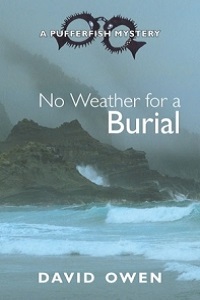
Title: No Weather For A Burial
Author: David Owen
Pages: 153
Published Date: 2010
Publisher: Forty Degrees South Publishing
Series Details: 5th book in the Pufferfish series
Publisher's Synopsis
How long should long service leave be?
Pufferfish, aka Detective Inspector Franz Heineken, scourge of Tasmania's villains, is back. And back with a seriously refreshed vengeance. Pufferfish, prickly, curmudgeonly and irony-charged as ever, is attracted to an unusual stench in his island paradise: a badly decomposing corpse with no name, identity altered prior to execution, victim of a puzzling mix of professionalism and panic. And a possible mainland connection to Australia's feared OMCGs - Outlaw Motorcycle Gangs. Bring on the long-transplanted Dutch plod, eh.
Together with colleague DS Hedda Andover (his close mate in and beyond the force) and fighting the antagonism of his boss, odious Walter D'Hayt, Pufferfish has a deadly choice to make: how, in the snowy wilderness of a World Heritage Area, to bail up a pair of manic killers while protecting his own?
My Review
No Weather For A Burial by David Owen is the 5th book in the Pufferfish series, a police procedural series set in Tasmania, Australia. This is a series that has developed into a very enjoyable one thanks to the very offbeat and colourful nature of the main character, Detective Inspector Franz Heineken. After a 13 year break the fifth book in the series has picked up with Heineken returning to work after taking long service leave.
The discovery of a body on a remote stretch of beach calls Heineken out for his first job back on duty. The unknown body has been wrapped in a sack and buried in the sandhills of the beach, a murder that starts with a great many unknowns including who the dead man is and how he came to be occupying a burlap sack.
Although Heineken has been taking a break he hasn’t lost his dislike for his boss Detective Superintendent Walter D’Hayt. His true feelings are best summed up by the brief observation that d’Hayt is "a painful stickler, a goody two shoes - we call him GTS - a supercilious, vainglorious prick."
As well as the incisive wit of the main character and the crime that is picked apart and solved in a well ordered fashion, the other main feature of the book, not to mention the entire series, is the harshly beautiful landscape of Tasmania. The landscape is described in achingly beautiful detail that begs the reader to come and visit just to behold the raw wonder it holds. Although Heineken is a transplant to the state there is no doubt that he continues to marvel over the splendour of the countryside.
Take the following observation as Franz flies back in to Hobart:
Sheet rain falls across the Organ Pipes of Mount Wellington and the dark green silhouette of hills linking it to Mount Dromedary. Sunlight slants through shifting cloud masses. From the eastern shore, approaching the bridge, Hobart and her outer suburbs, and the pair of flags rippling energetically at Government House, have a strange unreality about them, a hyper reality brought on by a massive rainbow. This place is home to the likes of me.
Heineken himself has mellowed in his demeanour over the years from the early days in Pig’s Head and although he is no longer completely hostile to those he works with, he still works best on his own. The development of his subordinates Detective Rafe Tredway and Constable Faye Addison continue to provide a competent foil for the gruff exterior he displays creating a team that functions with plenty of aptitude.
David Owen is a master storyteller and a true ambassador for the state of Tasmania. The state of Tasmania is featured prominently as a vital part of the story and makes it all the more memorable for the forbidding landscapes that are described along the way.